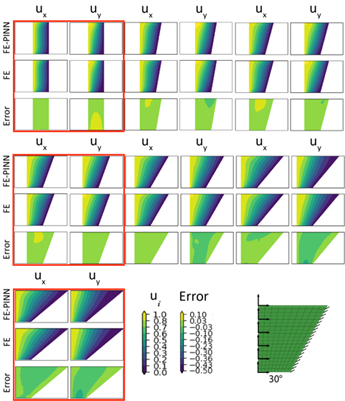
Comparison of FE-PINN predictions with FEM solutions. Red-boxed cases were used for training, all other cases are predictions. Example mesh with boundary conditions marked is shown in lower right.
Invention Summary:
The finite element method (FEM) has emerged as a powerful technique for modeling physical problems in various disciplines. Such models can be very accurate and fully interpretable, but usually have relatively larger computational cost for large systems.
Rutgers researchers have developed a FE-PINN (finite element-physics-informed neural network) technology, which enables training of computationally efficient surrogate models using existing finite element codes without requiring large data sets. The core innovations are a new convolutional operator and loss function which couple to the FEM. As a result, FE-PINNs are plug-and-play with existing finite element codes so that surrogate models can be developed for any physical model/problem available in a given code. FE-PINNs take standard finite element meshes as input, so that all existing mesh generation infrastructure can be leveraged. The result is a framework that can be used to train surrogate models which solve 100 to 10,000 times faster than an FEM solver. Such surrogate models could obviate the need for FEM codes as a commercial product (e.g., neural networks replace existing solvers).
Advantages:
- Low computational time and resources required to solve complex problems.
- Can be used on an irregular domain.
- Boundary conditions are automatically imposed using FEM.
Market Applications:
This computational method can solve complex problems in the field of:
- Solid and fluid mechanics
- Electromagnetic radiation
- Heat transfer
Publications: "FE-PINNs: finite-element-based physics-informed neural networks for surrogate modeling." https://arxiv.org/abs/2412.07126
Intellectual Property & Development Status:
PCT patent application filed, patent pending. Available for licensing and/or research collaboration. For any business development and other collaborative partnerships contact marketingbd@research.rutgers.edu.